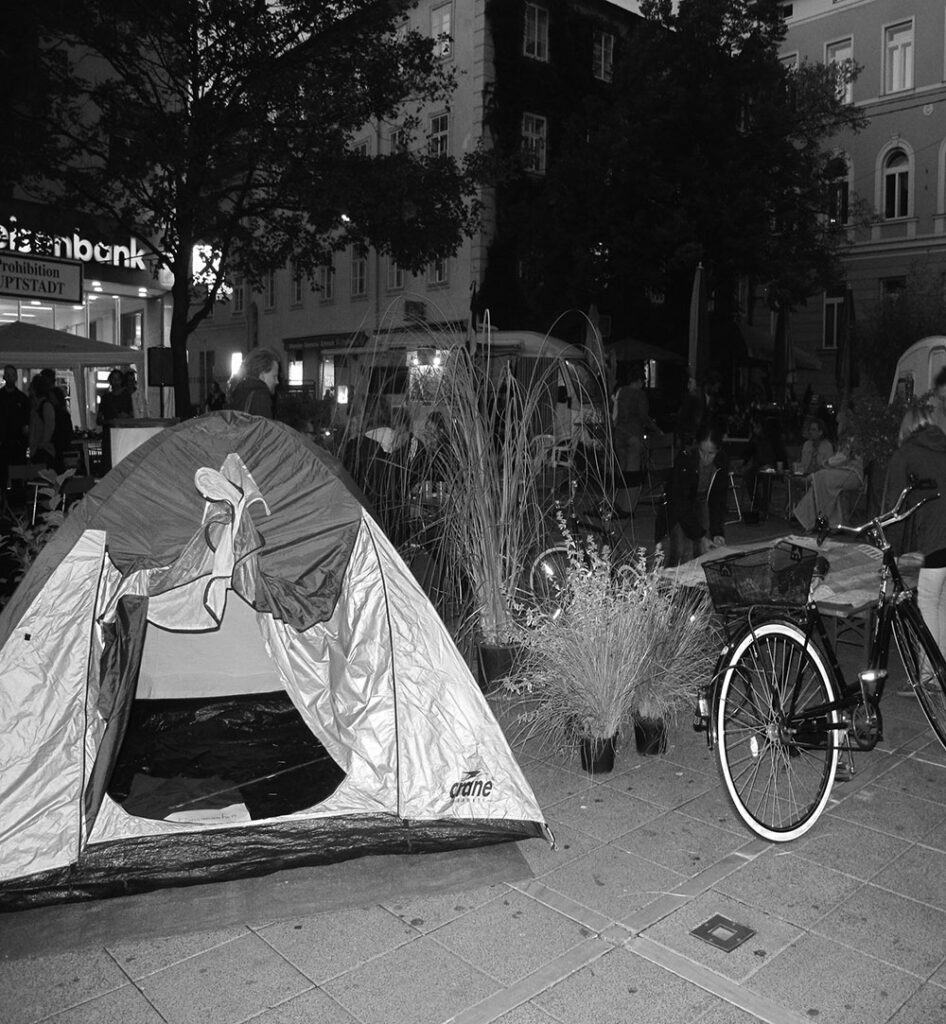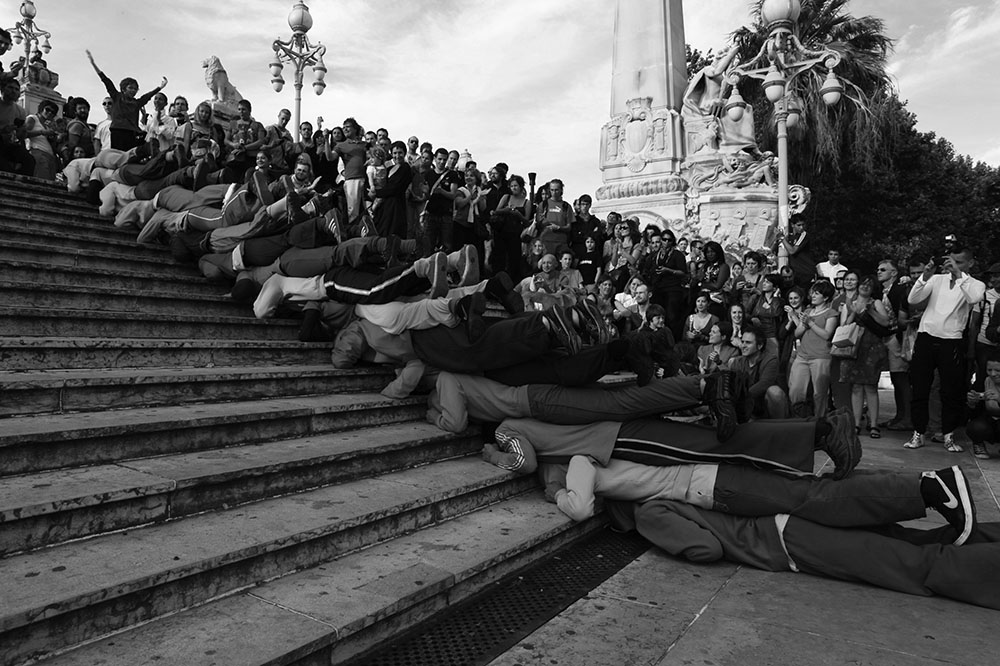Brigitte Kratzwald / Version 2
Urban Commons – Experiments in Contested Spaces
More than half of the world’s population already lives in cities, and that number continues to grow. Many are drawn to urban areas in hopes of finding work and a better standard of living—hopes that are often unmet. At the same time, investors are increasingly targeting cities, constantly seeking new opportunities for profit, and politics is only too willing to reshape cities primarily for their benefit. This pressure to exploit urban spaces—driven in part by empty public coffers—is causing free and open spaces to vanish, transforming public space into zones of consumption. The quality of life and the needs of city dwellers are increasingly being pushed aside. Whether it’s trees in public parks being felled for controversial megaprojects, listed historic buildings making way for supermarkets or office towers, or the exclusion of those who don’t fit the image of the “smart city”—resistance is growing. More and more people are claiming their right to take part in shaping the environment they live in.
The question “Who owns the city?” has long since left the circles of anarchist squatters and radical citizens‘ initiatives. The demand for planning processes to be opened up is now on the table and can no longer be brushed aside. The question of the city of the future and the associated spatial conflicts are preoccupying politics, science and art. Rarely does a month pass without a conference, a grassroots event, or an art project on the subject. In some places, however, this creative appropriations risk being co-opted by an increasingly commercialized festival culture, losing their political edge. In the context of these processes of negotiation, expropriation and re-appropriation of urban space, the term “urban commons” is experiencing unexpected heights, denoting a wide range of different projects and activities. But is it just a buzzword, or does it offer real substance? What does it mean to define urban spaces as commons?
If we understand commons not as static entities but as social relationships and processes, in which users negotiate rules for the use and reproduction of shared resources, then following Henri Lefèbvre ’s spatial theory, we can see urban commons primarily as processes of producing spaces of resistance. Space itself already has qualities that make it particularly suitable for use as commons. Like commons, spaces are not rigid entities—they don’t “exist” in a static sense, but are constantly produced, reproduced, and transformed through conflict-laden social interactions. They also have boundaries—but these, too, are not fixed or linear. They are border areas: shifting, expanding, becoming cracks in the urban fabric where exchange happens, or niches where something new can emerge. Stavros Stavrides has used the term “thresholds” rather than “boundaries” in this context, speaking of cities of thresholds and porosity.1
At the same time, the concept of the commons also poses a radical challenge to the very idea of ownership—it is a reaction to increasing experiences of dispossession. Housing has become an investment vehicle, increasingly unaffordable for many. Public benches are disappearing, as are drinking fountains—Germany’s train stations, shopping malls with direct consumer targeting are prime examples. In Austria, at least people are still allowed to sit, though not lie down—armrests between seats ensure that. Omnipresent surveillance cameras cast a troubling light on what “public” actually means. While public space in a democracy should enable political dialogue and civic engagement, the trend is shifting toward the idea of the “public individual”—always watched, always monitored—and away from truly public spaces that are accessible to all. The privatization of public services and infrastructure is also contributing to the fact that more and more people are beginning to oppose these processes. The simultaneity of resistance and creative, productive appropriation is a core strength of the commons. “Who owns the city?” is no longer just a rhetorical question. Protest no longer stops at critique and demands but is increasingly accompanied by collective, concrete, and creative re-appropriation processes through which spaces are redefined. However, the diverse user groups in a confined space make commoning in cities a particularly conflict-ridden challenge that requires a great deal of negotiating skill and tolerance.
Commons are also deeply tied to human dignity, autonomy, and democracy—to the right to a good life, to social participation, to the opportunity of shaping one’s own life. In the Global South, and in crisis-ridden parts of Europe, the production of life’s necessities “beyond market and state”2 has become a matter of survival. Here, urban commons fulfill the life-sustaining functions once held by commons in agrarian societies. But even in industrialized cities, the use of urban space for food production has taken on new significance. Guerilla gardening, urban gardening, edible cities—where asphalt, manicured lawns and ornamental shrubs dominated just a few years ago, pumpkins, tomatoes and radishes are now thriving, often with the support or at least toleration of municipal governments. One key principle of commoning is the recognition of autonomous self-organization by public authorities. However, when it comes to squatting—a form of urban commoning that responds to unaffordable rents and large numbers of vacant buildings—governments are typically less tolerant.
Many urban commons are temporary projects, embedded in ambivalent ways within a capitalist environment. Urban hacking, for instance, involves repurposing city space for alternative uses: feeding coins into a parking meter to transform a short-term parking zone into a picnic area, playground, or garden; turning a construction dumpster into a mini-bistro; walking in circles around a traffic island, in large numbers and for a long time; or building a wooden “walking vehicle” the size of a car to reclaim space on foot. Urban commons are spaces for experimentation and learning—for a future that has yet to be created. People there experience themselves as actors, as producers of their living environment. Even if these commons eventually disappear, they transform those who participate, expanding their capacity to think and act—and they often reappear unexpectedly elsewhere.
“If we can look at an abandoned building and imagine it full of people / if we can look at a vacant lot and imagine it a garden, / then why can’t we look at each other and imagine what we can become with time and work? / It is a good thing to take up the struggle against oppression / it is a good thing to make mistakes in that struggle and grow wise. / How else would we come to know ourselves?”3
1Stavrides, Stavros (2011): Towards the city of thresholds. Professionaldreamers, Trento
2This is the title of the book by Ostrom, Elinor (1999): Die Verfassung der Allmende. Jenseits von Markt und Staat. Mohr Siebeck, Tübingen
3Tobobmann, Seth (1999): War in the neighborhood: A Graphic Novel. Autonomedia, New York, p. 328 cited from: Thompson, AK (2010): Black Bloc, White Riot. Anti-Globalization and the Genealogy of Dissent. AK Press, Edinbourgh/Oakland/Baltimore, p.19.



